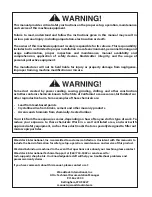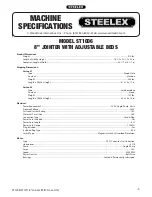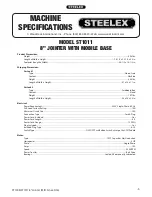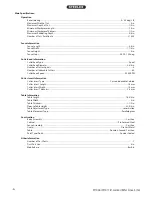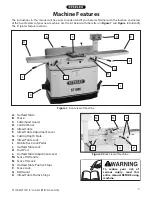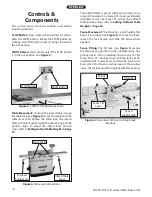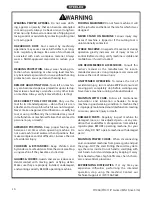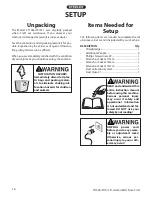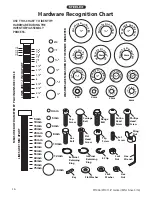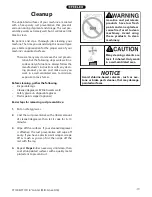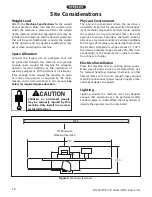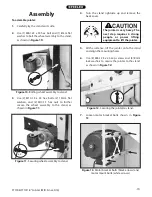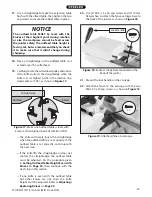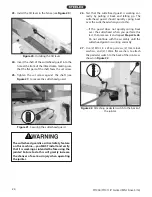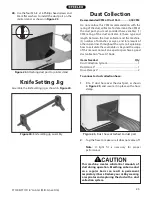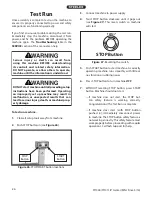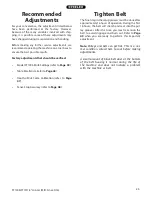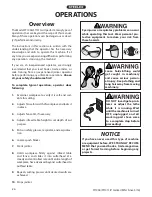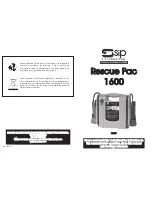
ST1006/ST1011 8" Jointer (Mfd. Since 3/16)
-11-
Additional Safety for Jointers
Serious cuts, amputation, entanglement, or death can occur from contact with rotating cutterhead
or other moving components! Flying chips can cause blindness or eye injuries. Workpieces or inserts/
knives thrown by cutterhead can strike nearby operator or bystanders with deadly force. To reduce
the risk of these hazards, operator and bystanders MUST completely heed the hazards and warnings
KICKBACK. Occurs when workpiece is ejected from
machine at a high rate of speed. To reduce the risk
of kickback-related injuries, use quality workpieces,
safe feeding techniques, and proper machine setup
or maintenance.
GUARD REMOVAL. Operating jointer without guard
exposes operator to knives/inserts. Except when rab-
beting, never remove guards for regular operations
or while connected to power. Turn jointer OFF and
disconnect power before clearing any shavings or
sawdust from around cutterhead. After rabbeting
or maintenance is complete, immediately replace all
guards and ensure they are properly adjusted before
resuming regular operations.
DULL/DAMAGED KNIVES/INSERTS. Dull knives/
inserts can increase risk of kickback and cause poor
workpiece finish. Only use sharp, undamaged knives/
inserts.
OUTFEED TABLE ALIGNMENT. Setting outfeed
table too high can cause workpiece to hit table and
get stuck, increasing risk of kickback. Setting out-
feed table too low may cause workpiece to become
tapered from front to back. Always keep outfeed
table even with knives/inserts at top dead center
(highest point during rotation).
INSPECTING STOCK. Impact injuries or fire may
result from using poor workpieces. Thoroughly
inspect and prepare workpiece before cutting. Verify
workpiece is free of nails, staples, loose knots or other
foreign material. Workpieces with minor warping
should be surface planed first with cupped side fac-
ing infeed table.
GRAIN DIRECTION. Jointing against the grain or end
grain can increase the risk of kickback. It also requires
more cutting force, which produces chatter or exces-
sive chip out. Always joint or surface plane WITH the
grain.
MAXIMUM CUTTING DEPTH. To reduce risk of kick-
back, never cut deeper than
1
⁄
8
" per pass.
CUTTING LIMITATIONS. Cutting a workpiece that
does not meet the minimum dimension require-
ments can result in breakup, kickback, or accidental
contact with cutterhead during operation. Never
perform jointing, planing, or rabbeting cuts on pieces
smaller than 8" long,
3
⁄
4
" wide, or
1
⁄
4
" thick.
PUSH BLOCKS. Not using push blocks when surface
planing may result in accidental cutterhead contact.
Always use push blocks when planing materials less
than 3" high or wide. Never pass your hands directly
over cutterhead without a push block.
WORKPIECE SUPPORT. Loss of workpiece control
while feeding can increase risk of kickback or acci-
dental contact with cutterhead. Support workpiece
continuously during operation. Position and guide
workpiece with fence. Support long or wide stock
with auxiliary stands.
FEED WORKPIECE PROPERLY. Kickback or acciden-
tal cutterhead contact may result if workpiece is fed
into cutterhead the wrong way. Allow cutterhead to
reach full speed before feeding. Never start jointer
with workpiece touching cutterhead. Always feed
workpiece from infeed side to outfeed side without
stopping until cut is complete. Never back work
toward infeed table.
SECURE KNIVES/INSERTS. Loose knives or improp-
erly set inserts can become dangerous projectiles or
cause machine damage. Always verify knives/inserts
are secure and properly adjusted before operation.
Straight knives should never project more than
1
⁄
8
"
(0.125") from cutterhead body.


